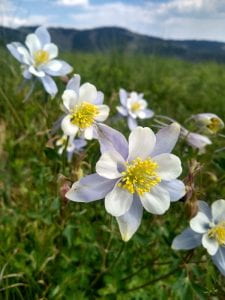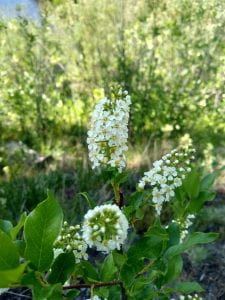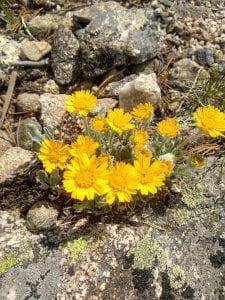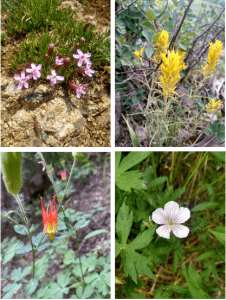
By Zachary Scott
During our field trip to Minturn, Colorado, we had the opportunity to experience some of the region’s amazing geology up close – driving on perilously winding mountain roads, hiking up to the gorgeous Saint Mary’s glacier, and even digging around for fool’s gold (pyrite) and other minerals at an abandoned mining location! The Minturn area is truly blessed with fascinating geological features, and spending the week learning about the interactions of rock, water, and ice and the effects that these dynamic systems have on the people living in the city was both fun and unforgettable. Geology, however, was far from the only thing that was catching our eyes during our expedition to Colorado – for we were completely surrounded by a landscape alive with biological diversity as well!
In particular, many of us fell in love with the colorful wildflowers that dotted the landscape like tiny splotches of paint against a background of green pine trees and white quaking aspens. From the wettest foothills to the highest peaks, each location we visited introduced us to wildflowers that we hadn’t encountered before, helping us further appreciate the impressive biodiversity of the region. In the end, we observed over forty species of flowering plants – a fairly impressive total considering the shortness of our visit! As is natural, however, all of us had our favorites, so I wanted to feature everyone’s top pick and some of the characteristics that make each of them stand out.
Our Favorite Wildflowers!

Common Name: Silky Lupine
Scientific Name: Lupinus sericeus Pursh
Janae’s favorite flower was the silky lupine, which is also known as the blue-bonnet lupine. The beautiful plant grows in a wide variety of habitats throughout the western United States and plays an important role as a nitrogen fixer for soils. Although the plant is toxic to most domestic wildlife, it attracts a large number of pollinators such as hummingbirds and native bee species, giving it a valuable role in native plant communities.

Common Name: Heartleaf Arnica
Scientific Name: Arnica cordifolia
Kayla’s favorite flower was the heartleaf arnica, a plant that is distributed throughout the western U.S., Canada, and even into Michigan. It grows commonly in cooler forest climates and elevations from 5000 to 11,000 feet. Indigenous communities in the U.S. and Europe valued the plant for medicinal purposes – from slowing bleeding to soothing sore throats.

Common Name: Silky Phacelia
Scientific Name: Phacelia sericea
“It looks like if a bluebonnet and a hairy caterpillar had a baby” said Chris about the silky phacelia, his favorite wildflower from the trip. This is an apt description for the cool-weather-loving plant, which thrives throughout the Rocky Mountain region. Interestingly, the plant has the ability to accumulate fairly high concentrations of gold in its tissues (although still only 21 parts per billion, so don’t expect the plant to set off another gold rush).

Common Name: Colorado Blue Columbine
Scientific Name: Aquilegia caerulea James
Neel’s favorite wildflower from our trip was the stunning Colorado blue columbine, which, as the name suggests, is also the state flower of Colorado. The plant grows in a number of environments throughout the Rocky Mountains, especially aspen groves, meadows, and open forests. Unsurprisingly, the flower is extremely popular amongst photographers – but pollinators love it as well!

Common Name: Chokecherry
Scientific Name: Prunus virginiana
Although technically not a wildflower, Liz’s top flowering plant from the trip was the chokecherry, which is a shrub or small tree that is found in almost every state of the U.S. Because of its widespread distribution, this member of the rose family has a long history of being used by both Indigenous groups and European colonizers alike for a wide range of medical treatments. Caution is needed, however, because some portions of the plant contain the highly toxic hydrocyanic acid, which can be deadly.
 Common Name: Rock Clematis
Common Name: Rock Clematis
Scientific Name: Clematis Columbiana
Trinity’s favorite wildflower from the Minturn trip was the rock clematis, which is also (rather unhelpfully) known as the blue clematis. This uncommon climbing plant is native to the Rocky Mountains, but its beauty has taken it to gardens across the United States. After blooming, the flower is replaced by a fluffy-looking (but very fragile) seedhead. The plant often grows on talus slopes, which are piles of accumulated rock fragments at the base of cliffs or steep slopes.

Common Name: Alpine Sunflower, Old-Man-of-the-Mountain
Scientific Name: Tetraneuris grandiflora
Last but not least, my (Zach’s) favorite wildflower from our Colorado trip was the alpine sunflower, a pretty plant that grows in the harsh conditions of the alpine tundra. The very short plants (normally about four inches tall) are known for their large flowers and very hairy stems and leaves, which is evident in our picture to the left. According to conventional wisdom, the flowers almost always point to the east, but it probably isn’t the best idea to rely on them as a compass!
Honorable Mentions!
Even though nobody selected the following wildflowers as their favorite from the trip, it wouldn’t be right not to feature a few of the other flowers that we spotted. To be completely honest, I think that picking just one flower to be a favorite is impossible – because all of them are unique and interesting!

Clockwise from top left: Moss Campion, Yellow Owl’s-Clover, Richardson’s Geranium, Western Red Columbine
Beautiful Lessons
When we see wildflowers, we often appreciate their colors, shapes, and overall beauty as they add color into the world around us. On our trip to Minturn, however, much of our group also started recognizing how flowers can be more than just eye candy – they can also teach us about the surrounding environment! One thing that we noticed as we traveled around the Minturn area was the connection between the wildflowers that were present and the elevation of their habitats. While plants such as chokecherry or rock clematis appeared at relatively lower elevations, others – like moss campion and alpine sunflower – were some of the only flowering species as we went up to the tree line at about 11,000 feet.
Each flower had adaptations that allowed them to thrive at specific elevations and conditions of temperature, light, etc., which meant that the presence (or absence) of any flower gave us information about the conditions of the environment. This pattern was very evident on one of our last days in Colorado, as we hiked down to Minturn from the Vail Ski Resort. As we trekked down from the resort at about 10,000 feet to our hotel at 7,800 feet, we passed through alpine meadows, mountain brush, and aspen forests that all had different communities of wildflowers, which we could then use to learn more about our surroundings. It was really surprising to realize how much we can infer about geology and climate based on nothing more than the flowers that we see, which is a lesson that I think each of us hopes to carry forward and use in future situations. Our wildflower observations helped us connect biology and natural history to the geological landscapes around us, adding yet another layer of perspective to our amazing trip to Minturn.
For anyone else who also has a minor wildflower obsession, there are tons of amazing resources online to learn more about the flora that surrounds us! For this post, the fun facts about everyone’s favorite flowers came from the following sources — so check them out to learn more and explore the fascinating world of wildflowers.
Silky Lupine
https://www.westernnativeseed.com/plant%20guides/lupserpg.pdf
https://www.fs.fed.us/database/feis/plants/forb/lupser/all.html
Heartleaf Arnica
https://extension.usu.edu/rangeplants/forbsherbaceous/heartleaf-arnica
https://www.fs.fed.us/wildflowers/plant-of-the-week/arnica_cordifolia.shtml
Silky Phacelia
https://www.fs.fed.us/wildflowers/plant-of-the-week/phacelia_sericea.shtml
https://plants.usda.gov/home/plantProfile?symbol=PHSE
Colorado Blue Columbine
https://www.fs.fed.us/wildflowers/plant-of-the-week/aquilegia_caerulea.shtml
https://plants.usda.gov/home/plantProfile?symbol=AQCO
Chokecherry
https://www.wildflower.org/plants/result.php?id_plant=PRVI
https://www.nrcs.usda.gov/Internet/FSE_PLANTMATERIALS/publications/kspmcpg5596.pdf
Rock Clematis
https://www.wildflower.org/plants/result.php?id_plant=clco2
Alpine Sunflower
https://www.fs.fed.us/wildflowers/plant-of-the-week/tetraneuris_grandiflora.shtml
